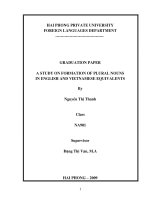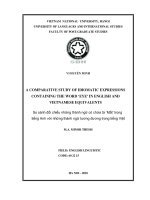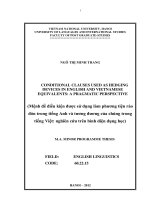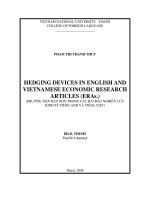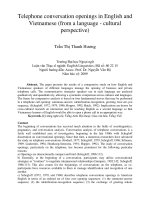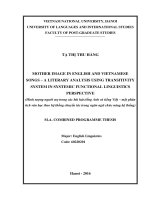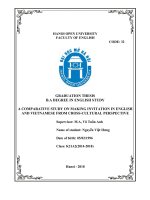conditional clauses used as hedging devices in english and vietnamese equivalents a pragmatic perspective = mệnh đề điều kiện được sử dụng làm phương tiện rào đón trong tiếng anh và tương đương
Bạn đang xem bản rút gọn của tài liệu. Xem và tải ngay bản đầy đủ của tài liệu tại đây (746.09 KB, 59 trang )
i
VIETNAM NATIONAL UNIVERSITY, HANOI
UNIVERSITY OF LANGUAGES AND INTERNATIONAL STUDIES
FACULTY OF POST GRADUATE-STUDIES
****************************************
NGÔ THỊ MINH TRANG
CONDITIONAL CLAUSES USED AS HEDGING
DEVICES IN ENGLISH AND VIETNAMESE
EQUIVALENTS: A PRAGMATIC PERSPECTIVE
(Mệnh đề điều kiện được sử dụng làm phương tiện rào
đón trong tiếng Anh và tương đương của chúng trong
tiếng Việt: nghiên cứu trên bình diện dụng học)
M.A. MINOR PROGRAMME THESIS
FIELD: ENGLISH LINGUISTICS
CODE: 60.22.15
HANOI – 2012
ii
VIETNAM NATIONAL UNIVERSITY, HANOI
UNIVERSITY OF LANGUAGES AND INTERNATIONAL STUDIES
FACULTY OF POST GRADUATE-STUDIES
****************************************
NGÔ THỊ MINH TRANG
CONDITIONAL CLAUSES USED AS HEDGING DEVICES
IN ENGLISH AND VIETNAMESE EQUIVALENTS: A
PRAGMATIC PERSPECTIVE
(Mệnh đề điều kiện được sử dụng làm phương tiện rào đón trong tiếng
Anh và tương đương của chúng trong tiếng Việt: nghiên cứu trên bình
diện dụng học)
M.A. MINOR PROGRAMME THESIS
FIELD: ENGLISH LINGUISTICS
CODE: 60.22.15
SUPERVISOR: DR. NGÔ HỮU HOÀNG
HANOI – 2012
iv
TABLE OF CONTENTS
CANDIDATE’S STATEMENT i
ACKNOWLEDGEMENT ii
ABSTRACT iii
LIST OF ABBREVIATIONS iv
LIST OF FIGURES v
PART A: INTRODUCTION 1
1. Rationale of the Study 1
2. Objectives of the Study 3
3. Scope of the Study 3
4. Methods of the Study 4
4.1. Methods 4
4.2. Introduction of the novella 4
5. Design of the Study 5
PART B: DEVELOPMENT 6
CHAPTER ONE: THEORETICAL BACKGROUND 6
1.1. The Concept of Hedging 6
1.1.1. Definitions of Hedge 6
1.1.2. Forms of Hedges 8
1.1.3. Functions of Hedges 9
1.2. Cooperative Principle 10
v
1.3. Politeness Theory 12
1.3.1. Politeness and Face 12
1.3.2. Face Saving Acts versus Face Threatening Acts 13
1.3.3. Grice‟s Cooperative Principle and Brown and Levinson‟s Politeness Theory
14
1.4. The Concept of Conditionals 14
1.4.1. Definition of Conditional Sentences 14
1.4.2. True Conditionals 15
1.4.3. Pseudo-Conditionals 17
CHAPTER TWO: IF-HEDGING AND POLITENESS 19
2.1. If-hedging and Cooperative Principle 19
2.1.1. If-hedging and Maxim of Quality 19
2.1.2. If-hedging and Maxim of Quantity 20
2.1.3. If-hedging and Maxim of Relation 21
2.1.4. If-hedging and Maxim of Manner 22
2.2. If-hedging and Politeness Principle 24
CHAPTER THREE: DATA ANALYSIS AND FINDINGS 28
3.1. True Conditionals and Pseudo-Conditionals Occurrence Rate 28
3.2. Pragmatic functions of Pseudo-Conditionals in English and Vietnamese
equivalents 30
3.3. Suggestions on teaching and learning English conditionals 38
3.4. Suggestions on translating English conditionals 39
vi
PART C: CONCLUSIONS 40
1. Conclusions 40
2. Limitations 41
3. Suggestions for Further Study 41
REFERENCES 42
APPENDIXES I
Appendix 1: English Conditionals I
Appendix 2: English Pseudo-Conditionals and Vietnamese Equivalents VII
vii
LIST OF ABBREVIATIONS
EFL: English as a Foreign Language
ELT: English Language Teaching
FTA: Face Threatening Act
FSA: Face Saving Act
LIST OF FIGURES
Table 3.1: The percentage of true conditionals and pseudo-conditionals
Table 3.2: The number of true conditionals and pseudo-conditionals
1
PART A
INTRODUCTION
1. RATIONALE OF THE STUDY
Up to date, linguistics has followed logicians in analyzing conditional
sentences in light of material implication. However, in spite of such a long period of
theorization and application of various approaches, there has been no agreed-upon
method of teaching English conditionals so far. Some teachers teach conditional
sentences and subjunctive mood side by side, some teachers teach them separately,
and teachers use different ways to classify conditional sentences. Overall, current ELT
coursebooks have essentially utilized the typology in Logic (real, counterfactual and
hypothetical), which they term first, second and third types respectively, with the
addition of two more types: zero and mixed. The vast majority of ELT materials
provide information about the following aspects of conditional sentences:
a. The tense-aspect marking of the main verbs in the If-clause and main clause.
b. The modal auxiliaries that can be used in each clause.
c. The time reference of the conditional sentence (not of each clause).
d. The user‟s attitude towards possibility.
(Gabrielatos, 2003)
Nevertheless, there has been considerable difference of opinion and much
terminological confusion in the area of pragmatic functions. Let consider the following
examples:
(1) If Squiggly knows the answer, he'll tell us.
(2) If Squiggly knows the answer, he isn‟t saying.
2
In the sentence (1), the result clause “he'll tell us”- is dependent on the “if'-
clause”. But this is not the case in the sentence (2) where “If-clauses” does not express
a condition and result; but implies “Squiggly isn‟t saying anything, whether he knows
the answer or not”. And the same is true for the other examples which do not fit into
the 1, 2, 3 system, for example:
(3) If I may interrupt, when is the next train?
(4) If you kindly allow me, I‟ll have a meeting with you in the evening.
As can be seen, the If-clauses in the examples (3) and (4) are not dependent on
the main clauses, and they could equally be expressed as a politeness marker used in
speech act of requesting to avoid imposition on the hearer and mitigate the negative
effect of refusals in communication. These so-called conditionals are also used in
Vietnamese, causing a lot of confusing for learners to determine the type of
conditionals:
Nếu mai rảnh thì qua nhà tớ chơi nhé!
Nếu không phiền, cậu nhặt hộ tớ mớ rau nha!
Vietnamese, like English, has developed through usage; as the result, language
patterns may refuse to be forced into a logically consistent mold. One of the reasons
for the lack of appropriate system to categorize conditionals may be the inherent
flexibility of the language itself. In this case, teachers have to base on pragmatics‟
point of view to explain these so-called conditionals. Since conditional sentences are
basic to the material of grammar and pragmatics, a detailed understanding of
conditional sentences is vital for an accurate interpretation of its contents.
In consideration of the importance of conditionals in teaching and learning English
as well as the fact that limited research has been done to evaluate pragmatic functions of
conditionals, especially in Vietnamese context, the researcher has decided to undertake
the study entitled “Conditional Clauses Used as Hedges in English and Vietnamese
Equivalents: a Pragmatic Perspective” in order to provide the more comprehensive
analysis on conditionals regarding pragmatic point of view.
3
2. OBJECTIVES OF THE STUDY
The study has been done in an effort to determine the pragmatic functions of
conditionals in English and Vietnamese equivalents. Particularly, the study addresses the
following primary objectives:
1. To distinguish the conditionals as hedging devices from true conditionals
2. To identify the pragmatic functions of If-hedging comparing to Vietnamese
equivalents
3. To suggest some implications for teaching, learning and translating English
conditional sentences
The researcher hopes that this study cannot only bring together the fields of
conditionals in grammar and pragmatics but also propose guidelines for EFL teachers
who wish to implement conditionals to enhance their students‟ language proficiency as
well as communicative competence. Equally, this study is hoped to provide Vietnamese
learners with the approaches of translating conditional sentences and some ways to help
Vietnamese learners of English overcome the difficulties in translating conditional
sentences. By carrying out this study, the researcher also hopes that conditionals can
receive more attention and enjoy more popularity among linguistics researchers so that
English education in Vietnam can actually equip students with communicative
competence.
3. SCOPE OF THE STUDY
Due to the scope of a minor thesis, limited time and experience, it is impossible
to cover all contrastive pragmatic matters. Hence, this study just concentrates on
pragmatic functions of If-clauses relating to the context in which If-clauses function as
a politeness marker in a certain speech act. Also, the study explains pragmatic
functions of If-clauses as a hedging device basing on Grice‟s Cooperative Principle
and Brown and Levinson‟s Politeness Theory in consideration of FTA and FSA.
Particularly, the pseudo-conditionals from the novella named The Little Princess are
4
used as data in this study. Detailed analysis and comparative study requires much time
and effort; therefore, semantic and syntactic theories are also employed at times to
help better analyze conditionals in English and Vietnamese equivalents.
4. METHODS OF THE STUDY
4.1. Methods
Such methods as descriptive, comparative and contrastive were employed to
describe and analyze, to compare and contrast the database in order to explore
similarities and differences in using English conditionals and Vietnamese equivalents.
Obviously, descriptive method was utilized to provide in-depth and detailed
description of conditionals in terms of pragmatics; whereas, comparative and
contrastive method was used to give a comparison and contrast relevant to pragmatic
properties of conditionals in English and Vietnamese equivalents.
A qualitative approach was also conducted to discover meanings that emerge
after careful documentation and thoughtful analysis for over approximately a five-
month period. The data were quantitatively converted into numeric patterns as the
primary basis for organizing and reporting results. It concentrates on smaller but
focused samples rather than large random samples. When studying the features of
sentence patterns used, as a result of quantification, the researcher can look for
recurring patterns emerging from the data.
4.2. Introduction of the novella
The Little Prince has been well-known all over the world because the novella
has captured the hearts and minds of both children and adults. Published by Harcourt
in 1943 and 1971, Katherine Woods' straightforward and beautiful translation is the
only one that does justice to The Little Prince. The novella is divided into 27 chapters,
each of which varies in length from less than a page to a maximum of 3 or 4 pages,
depending on the size of the edition read. While it presents itself primarily as a
narrative in the style of a journal, the book actually contains what may be interpreted
5
as two distinct story lines: one involving the story of the little prince, the other
involving the pilot/narrator.
The researcher chooses The Little Prince in English by Katherine Woods
(1971) and Vietnamese version by Nguyễn Tấn Đại (2001) as data to analyse because
it is interesting and reliable to measure how often conditionals might occur in a well-
known novel. Significantly, novel as a fictional piece of prose usually in a narrative
style should use a good language. Regardless of how it began, the novel has risen to
prominence and remained one of the most popular and treasured examples of human
culture and writing; therefore, analysing novel can assist the study to meet the
conditions on consideration of reliability and validity. Moreover, it is a nice and short
text which is available online for anyone to check that the researcher has done this
properly.
5. DESIGN OF THE STUDY
The thesis is divided into three parts as follows:
The first part is the Introduction, which presents the basic information such as:
rationale for the study, objectives of the study, scope of the study, research questions,
methods, as well as design of the thesis.
The second part is the Development of the study, divided into three chapters:
- Chapter 1 provides relevant theoretical background to this study.
- Chapter 2 examines the pragmatic relation of If - hedging with Cooperative
Principle and Politeness Principle in English and Vietnamese.
- Chapter 3 presents an analysis of the data as well as the interpretation of the
results in order to attain the objectives of the study.
The last part is the Conclusions which summarize what is addressed in the study,
points out the limitations and provides some suggestions for further study.
6
PART B
DEVELOPMENT
CHAPTER ONE
THEORETICAL BACKGROUND
This chapter provides the theoretical background of the thesis. It is divided into
four main sections; section 1 discusses the concept of Hedging, section 2 presents
Cooperative Principles, section 3 focuses on the Politeness Strategies, and section 4 deals
with the concept of Conditionals.
1.1. THE CONCEPT OF HEDGING
1.1.1. Definitions of Hedge
Hedging has been a major concern of various viewpoints such as cross cultural
comparisons, gender studies, translation studies, politeness theory, academic discourse
and so on over the last twenty years. In the literal sense, the term “hedge” and
“hedging” expresses the idea of “barrier”, “limit”, “defence”, or the way used to
protect or defend oneself. In the light of language, hedges have been defined in
various ways based on their forms and functions.
At the most basic level, Crystal (2008) defined hedge as “an application in
pragmatics and discourse analysis of a general sense of the word („to be non-
committal or evasive‟) to a range of items which express a notion of imprecision or
qualification”. Likewise, Richards and Schmidt (2010) described hedge as “a
mitigating device which is dedicated to decrease the impact of an utterance”. As can
be seen, both definitions of hedge come from pragmatics aspects regarding hedge as a
marker indicating how Gricean maxims are observed. In this case, hedges are
considered pragmatic markers which reinforce the influence of the message and hence
they appear to be associated mainly with the politeness strategies.
7
In literature, there are various linguistic expressions that can be considered as
hedges. According to Fraser (2010), Weinreich (1966) was the first person to mention
hedging in the linguistic field when he referred to „„meta-linguistic operators,‟‟ arguing
that for every language „„meta-linguistic operators‟‟ such as (in) English true, real, so-
called, strictly speaking, and the most powerful extrapolator of all, like, function as
instructions for the loose or strict interpretation of designate in his research literature
(1966: 163). However, it was Lakoff who officially introduced the term in 1972
bringing the greatest initial impact that popularized the concept of hedging. He
defined hedges as follows:
“For me, some of the most interesting questions are raised by the study of
words whose meaning implicitly involves fuzziness - words whose job it is to
make things fuzzier or less fuzzy. I will refer to such words as 'hedges'”
Lakoff (1972:195)
In Lakoff‟s point of view, hedging refers to words or phrases “whose job it
is to make things fuzzier” involving that the writer is less than fully committed
to the certainty of the referential information given. As Clemen (1997: 238) stated,
Lakoff merely concentrated on the logical relationships of words and the semantic
aspect of hedging. Furthermore, Clemen (1997: 238) indicated that Lakoff did not
consider context to be important for giving hedges their meaning but saw hedges as
independent lexical items with the capacity to make things 'fuzzier'.
Later on, Lakoff's pioneering opinions have been further developed by a
number of linguists. They have generally adopted a broader view on hedging,
considering it not only a semantic phenomenon but also a pragmatic one making a
great contribution to the interpersonal function of language.
Holmes (1982) demonstrates that hedges are devices which lessen the force of
an utterance thereby attenuating or reducing the strength of the utterance or softening /
weakening the effect of the utterance. In addition, she supports the idea that hedges
are for positive politeness. In simpler words, hedging means the way people express
8
their uncertainty about something or state something uncertain, and “hedges” are
words or phrase which carry the speaker‟s uncertainty (Bonano, 1982: 36). One reason
that speakers do not show certainty of what they say is that they want to indicate only
the criteria or type of criteria they find important at that time (Schmidt, 1974: 622).
In more technical definitions, hedges are particles, words, or phrases that
modify “the degree of membership of a predicate or noun phrase in a set” (Brown &
Levinson, 1987: 145). Remarkably, Brown and Levinson maintain both the
attenuation and the reinforcement aspects of hedging; revealing a fact that hedges are
“strengtheners” as well as “weakeners” which developed fully the speech act aspect of
hedging. Whereas Lakoff (1972) considers only propositional hedging and Fraser
(1975) concentrates only on performative verb hedging, Brown and Levinson deal
with the hedging of the illocutionary force of a speech act in term of politeness
phenomena.
As can be seen, research on hedges is difficult to clarify what hedging
expressions are. It lacks a solid definition of hedges and accordingly a profound
understanding of what might be used as a hedge. The complexity of these functional
definitions is that almost any linguistic item or expression can be used as a hedge.
This means that no clear-cut lists of hedging expressions are possible (Clemen, 1997:
6). Despite the difficulty in establishing definitions of hedges, there is some consensus
in the field that hedges should be discerned between the actual item and the function
of hedging in general. Regarding all the different approaches synthesized precisely by
Clemen (1998), hedging can be considered the general use of linguistic means to
mitigate the impact of an utterance; increasing the possibility of a better acceptance
and simultaneously minimizing the risk of rejection. In this case, hedging is thereby
nothing more than a way to relate to the maxims of conversation by Grice.
9
1.1.2. Forms of Hedges
In consideration of hedging in academic writing, Crompton (1997) along with
some defenders such as Skelton (1988b), Myers (1989), Salager-Meyer (1994) and
Hyland (1994) distinguishes hedges between forms as follows:
− copulas other than be (e.g. The result appears to be that )
− lexical verbs (e.g. The result suggests that )
− modal verbs (e.g. The result might be that )
− probability adverbs (e.g. The result possibly is that )
− probability adjectives (e.g. It is possible that the result )
(Crompton 1997: 280, examples added by Riekkinen (2009))
Additionally, hedging has been regarded to adhere to, for instance, If-clauses,
Time Adverbials and Passives (Hyland, 1994), Lexis Expressing Personal
Involvement (Salager-Meyer, 1994), All Clause Initial Adverbs (Skelton, 1988b), All
Devices Suggesting an Alternative (Myers, 1989). As can be seen even from this small
sample of references, the forms of hedge are an open-ended category.
1.1.3. Functions of Hedges
In common sense, hedges are most commonly concerned with either expressing
a lack of commitment to the truth of something the speaker utters (Lyons, 1977;
Coates, 1989; Markkanen & Schröder, 1989; Hyland, 1998) or alternatively softening
the force of the speaker's utterance such as softening claims (Hatch, 1992), softening
complaints, requests and commands (Brown & Levinson, 1987), softening
performatives (Lakoff, 1972; Fraser, 1975), and softening criticism (Drechsel, 1989).
Regarding the array of literature, hedges can function as cooperative devices in
conversation. For examples, quality hedges that diminish speaker‟s commitment may
10
redress advice or criticisms: “As far as I am concerned…” Quantity hedges may be
used to weaken complaints or requests: “Could you make this copy more or less
final?” Whereas, relevance hedges are intended to redress offers or suggestions: “This
may sound like dumb question but…”And manner hedges can be employed to redress
all kinds of FTAs: “If you see what I‟m driving at…”
Later, hedges can act as one of politeness strategies (Brown & Levinson, 1987;
Buikema & Roeters, 1982) by which we are able to “recognize the speech function,
the type of offer, command, statement, or question, the attitudes and judgments
embodied in it, and the rhetorical features that constitute it as a symbolic act”
(Halliday & Hassan, 1989:45). In plenty of previous work, hedging has been viewed
as a negative politeness strategy; however, it may simultaneously be seen to have a
positive politeness dimension. Brown and Levinson comment that one way to express
positive politeness toward one‟s addressee; to communicate “that one‟s own wants …
are in some respects similar to the addressee‟s wants” is to avoid disagreement (1987:
101).
As can be seen, the functions of hedges are manifold and can be separated from
one another. However, it is necessary to note that these functions can, and in fact often
do, overlap (Mauranen, 2004: 176). Some linguists would rather to deal with the
functions of hedging as overlapping without any clear-cut distinctions.
1.2. COOPERATIVE PRINCIPLE
In cooperation with Speech Act Theory (e.g. Austin, 1962 & Searle, 1969),
Grice‟s work on the Cooperative Principle initiates the current interest in pragmatics,
and leads to its development as a separate discipline within linguistics. Grice (1975:
45) defined Cooperative Principle as one of the important principles in conversation
that “make your contribution such as required, at the stage at which it occurs, by the
accepted purpose or direction of the talk exchange in which you are engaged”.
According to Grice (1975), there are four maxims under this general principle namely,
maxims of quantity, quality, relation and manner.
11
The maxim of Quantity:
- Make your contribution as informative as is required
- Do not make your contribution more informative than is required
The Maxim of Quality:
- Do not say what you believe to be false
- Do not say that for which you lack adequate evidence
The Maxim of Relation:
- Be relevant
The Maxim of Manner:
- Avoid obscurity of expression
- Avoid ambiguity
- Be brief (avoid unnecessary prolixity)
- Be orderly
Grice (1975:45)
The cooperative principle seems to be the basic framework of human speech
conduct. It can be seen clearly that the principle requires the conversation to be
precisely informative, truthful, relevant and explicit. However, while conversation
participants nearly always observe the Cooperative Principle, they do not always
observe these maxims strictly. Verschueren (2000: 33) stated that “…on many
occasions, the maxims will be breached or „flouted‟. But since speakers are expected
to be co-operative by using language in accordance with the maxims, any clear
breaching or flouting will be interpreted by a co-operative interlocutor as a conscious
act signaling special (implicit) meaning.” The Cooperative Principle accounts for the
12
relationship between the literal meaning and actual meaning, explaining how the
“Conversational Implicature” is produced and understood, but it does not explain why
people violate the conversational maxims so as to express themselves in a vague or an
indirect way.
1.3. POLITENESS THEORY
1.3.1. Politeness and Face
Politeness is defined as a common word that means “having or showing that
one has good manners and consideration for other people” (Oxford Advanced
Learners‟ Dictionary). In 1987, Brown and Levinson defined politeness as a form of
behavior enabling communication to take place between potentially aggressive
partners. Central to interpersonal politeness, Brown and Levinson‟s work is dealt with
two parts; the first part is their fundamental theory concerning the nature of
„politeness‟ and how it functions in interaction, whereas the second part is a list of
„politeness‟ strategies with examples from different languages (Kitamura, 2000).
In the theoretical part of their work, Brown and Levinson introduce the notion
of „face‟ in order to illustrate “politeness” in the broad sense. They confirm that
human beings have two kinds of face, namely “positive face” and “negative face”.
„Positive face‟ is described as the positive and consistent image people have of
themselves, and their desire for approval, whereas “negative face” is depicted as the
desire of every individual to have his/her own actions unimpeded by others (Brown &
Levinson, 1987). Additionally, the researchers assert that face is susceptible to face-
threatening acts (FTAs) such as orders, requests, warnings, remindings and threats,
and accordingly politeness strategies are employed with an aim to reduce the
imposition of FTAs. The significance of FTAs is evaluated in relation to three social
variables: the social distance between the speaker and the hearer, the relative power of
the speaker and the hearer and the ranking of impositions within a given culture
(Brown & Levinson, 1987). On the basis of a combination of these three variables,
speakers decide which of the following strategies to employ:
13
1. Bald on record - without redressive action: saying things directly, such as
“Turn the light on”
2. Positive politeness - expressing solidarity: “Be a good boy and turn the light
on”
3. Negative politeness - expressing restraint: using conventional indirectness: “I
wonder if you could turn the light on”
4. Off-record - using non-conventional indirectness: “It's dark in here”
5. Don't do the FTA
(Brown & Levinson, 1987)
Among the five strategies, positive and negative politeness strategies are most
discussed for their close relationship with „face‟which is based on the supposition that
the speaker wishes to mitigate the potential face-threat carried in his/her utterance in
order to maintain the hearer‟s want to be approved (positive politeness) or to be free
of imposition (negative politeness).
1.3.2. Face Saving Acts versus Face Threatening Acts
According to Brown and Levinson (1987), FSA is type of behavior through
which a person utters something that lessens the possible threat to another‟s face while
FTA functions as an illocutionary act that may threaten another person‟s face, for
example in orders, requests, warnings, dares, complaints, criticism, ridicule,
reprimands, insults, accusations, etc. Noticeably, FTA may threaten either the negative
or the positive face of the speaker or the hearer. Besides, they regard the redressive
action as “an action that gives face to an addressee” and indicate that the face-
threatening acts are modified via using various means that speaker employs
throughout the conversation (Brown & Levinson, 1987: 70). Moreover, they explain
that FTA sometimes occurs in a conversation and it can damage the face of the hearer
or the speaker because FTA is an opposite act to wants and desires of others. If people
14
want the communication runs well, they can defend each other's face or they can
also lessen the threat by using FSA.
To sum up, the major point of politeness is how to manage „face‟ in various
ways so that one‟s partner of communication will not lose his/her „face‟ or how to
save his/her face. Remarkably, it can be seen that the more indirect linguistic forms
people use (e.g. passive form, a supposition), the more polite the way of expression
will be.
1.3.4. GRICE’S COOPERATIVE PRINCIPLE AND BROWN AND
LEVINSON’S POLITENESS THEORY
On a more general level, Gricean model of Cooperative Principle is another
building block in Brown and Levinson‟s theory; that is, Grice‟s cooperative principle
is a tool to express Brown and Levinson‟s politeness theory in order for avoiding FTA
by utilizing FSA. Brown and Levinson notice the existence of a “model person” with
two special properties: rationality and face. They try to develop a model of politeness
which would have validity across cultures. The common factor in Brown and
Levinson‟s (1987) approaches is that they all claim, explicitly or implicitly, the
universality of their principles for linguistic politeness. The general idea is to
understand various strategies for interactive behaviours based on the fact that people
engage in rational behaviours to achieve the satisfaction of certain wants.
1.4. CONDITIONALS
1.4.1. Definition of Conditional Sentences
In common sense, conditionals are introduced by “if”, “unless”, or other
conjunctions which are usually interpreted in terms of aspectual or modal verb forms.
Such other conjunctions are often used as unless, providing that/ provided that, as long
as, only if, if only, on the condition that, assuming that, given that, supposed that/
supposing that, and so on. Besides, the term is sometimes employed to refer to the
15
entire two-part construction, including protasis and apodosis, which is aimed to
explain a particular situation or circumstance and its consequences.
In linguistics, conditionals are defined in various ways; however, few of them
provide clear-cut definition. For examples, Conditionals in “A Practical English
Grammar” (Thomson & Martinet, 1986) and Conditionals in “Comprehensive English
Grammar for Student” (Murphy, 1961) are only analyzed in lights of structures,
usages and variations. Later, Quirk (1987) came up with an idea which is regarded the
core of a definition about conditional sentence: “Conditional clauses state the
dependence of one circumstance or set of circumstances on another”. Furthermore,
Cobuild (1990) commented that: “Sentences containing conditional clauses are
sometimes called conditional sentences” and according to him, conditional clauses
begin with “if” or with conjunctions having similar meaning like “unless”. Regarding
the functions of Conditional clauses, Haiman (1978) convinces that conditional
clauses need studying from a discourse standpoint. Empirically, Akatsuka (1986)
indicates that conditionals belong to the domain of discourse and many of her
arguments in her 1985 paper are based on discourse considerations.
Via these theories above, it is accepted for most fields of language learning that
the expressions of conditionals can be manifested in different ways for different
intentions. Conditional Sentences can be regarded as one kind of complex sentence of
at least two main clauses “the main clause (result clause)” and “subordinate clause (if
clause)” which are aimed at performing the dependence of one circumstance or set of
circumstances on another. In others words, If-clauses set up the condition for the main
clauses to produce the result or outcome. However, the limitation of conditional
perceptions over grammar concerns was validated in the previous work and nowadays,
researchers are more curious about the different pragmatic functions within the
conditional construction from various subtypes.
16
1.4.2. True Conditionals
In grammar, a conditional sentence is a two-clause sentence in which the first
clause states a supposition or hypothesis and the second clause states the results if that
condition is met. Logically, a conditional is a compound statement formed by
combining two sentences (or facts) using the words "If then". The hypothetical
clause which states the condition ("If this . . .") is named the protasis and the
conclusion clause is termed the apodosis (". . . then this."). There are three main types
of Conditionals in English which is presented hereafter.
Conditional type I: if + present simple tense + modal verb with future
reference (e.g. will/shall/may). For instance:
If it rains, we will stay home.
He will arrive late unless he hurries up.
First conditional is often called the "real" conditional because it is used for
“real or possible” situations. Quirk (1972) stated that “The condition leaves
unresolved the question of the fulfilment or non-fulfilment of the condition and hence
also the truth of the proposition expressed by the main clause”. Likewise, Elbaum
(1986) defines this type of conditionals as “condition that has a possibility of
occurring”. It means that these situations take place if a certain condition is met.
Particular case related to First conditional is so-called Zero conditional when
the result of the condition is always true, like a scientific fact such as:
If you heat ice, it melts.
Obviously, Zero conditional is used when the result will always happen; the
result of the condition is an absolute certainty. Regarding sentence structure, it is
necessary to note that two clauses use the present simple tense to talk about the
condition.
17
Conditional type II: if + simple past tense + modal verb with future-in-the-
past reference (e.g. would, could, might). For example:
If he studied more, he would pass the exam.
They would buy a new house if they had more money.
Second conditional is called the "unreal" conditional because it is used for
unreal - impossible or improbable - situations. This conditional provides an imaginary
result for a given situation. The verb “to be”, when used in the 2
nd
conditional, is
always conjugated as “were”. According to Quirk (1972), “a hypothetical condition
conveys the expectation that the condition will not be fulfilled”. Later, Elbaum (1986)
stated that “An unreal condition tell about something that is not true or real. It makes a
supposition”. Moreover, Pyle and Munoz (1994) asserted that “The unreal conditional
expresses a situation (past, present or future) that would take place or would have
taken place if the circumstances expressed were or had been different now or in the
past”.
Conditional type III: if + past perfect tense + modal verb with future-in-the-
past reference (e.g. would/could/might) + have + ed participle:
If I had known you were sick, I would have sent you flowers.
If he had known that, he would have decided differently.
Like Second conditional, Third conditional is called the "unreal" conditional. It
is often referred to as the "past" conditional because it concerns only past situations
with hypothetical results. Mainly, it is utilized with an aim to express a hypothetical
result to a past given situation.
Syntactically, the condition is the subordinate clause, and the consequence is
the main clause. Therefore, the properties of the entire sentence are primarily
determined by the properties of the protasis (condition) (its tense and degree of
factualness). However, English conditional sentences are perceptibly multifold in
18
meaning because of a number of conditional signals with various meanings; hence, a
variety of pragmatic functions can be found in communication.
1.4.3. Pseudo-Conditionals
One of the arguments against the grammatical classification of conditionals is
that there are numerous sentences with If-clauses that cannot be depicted as 1st, 2nd
or 3rd Conditionals. In English, various conditionals that do not express hypothesis or
restriction as the 1, 2, 3 system have been criticised because the system could not
account for sentences like these:
If I may interrupt, what time is it?
If you think of it, pick up some soap on your way home.
(Fasold & Shuy, 1977)
These conditionals above are purposely utilized to soften the foregoing part of
the utterance that might be viewed as imposition. Remarkably, these sentences do not
seem to fit common types of conditional; both of them mean something like “if it's the
case that” and are examples of what is called Pseudo conditionals where the result
does not logically follow from the condition.
According to Wilamová (2005), pseudo-conditionals are illustrated by If-
clauses in the position of afterthoughts such as …, if I may say so, …, if I were you,
…, if you wanted to, …, if you like, …, if you insist, …, if it comes to that, …, if that
isn‟t an impertinent question, … This group of pragmatic markers is named pseudo-
conditionals because these If-clauses are not truly conditional sentences in their nature
as they syntactically lack the other part of the conditional structure and semantically
they lack the condition which has to be fulfilled before something else can happen
(Wilamová, 2005). Remarkably, Wilamova (2005) indicates that pseudo-conditional‟s
if-clauses are not one hundred percent conditional sentence because of the absence of
a characteristic conditional structure and a condition that should be in the conditionals
fulfilled.
19
CHAPTER TWO
“IF” HEDGING AND POLITENESS
This chapter analyzes the pragmatic functions of pseudo-conditionals as hedging
devices in English and Vietnamese basing on Grice‟s theory of Cooperative Principle and
Brown and Levinson‟s theory of Politeness Principle.
2.1. “IF” HEDGING AND COOPERATIVE PRINCIPLE
2.1.1. “If” Hedging and Maxim of Quality
Quality hedges may suggest that speakers do not taking full responsibility for
the truth of their utterance. Using these hedges, the speakers want the listeners to
discern what they are talking about is true in the given conditions but it can be false in
other situations:
If I remember correctly, Ann comes from America.
In the above example, if the speaker only says that “Ann comes from
America.” and she does not know for sure if Ann comes from America, she may
violate the maxim of quality since she say something that she does not know to be true
or false. Nevertheless, by adding “If I remember correctly”, the speaker wants to
confirm that she are observing the conversational maxim of quality.
If I remember correctly, these negotiations – and please correct me if I’m
wrong – weren‟t they seen as a way to avoid the situation was now find our self
in?
(Fraser, 2010)
Likewise, in Vietnamese we have some expressions like:
Nếu tôi nhớ không nhầm thì bài thơ này của một thi sĩ thời tiền chiến.
Nếu tôi đoán không sai thì thế nào hắn cũng đến đây.
